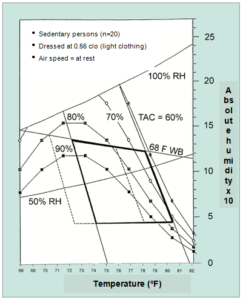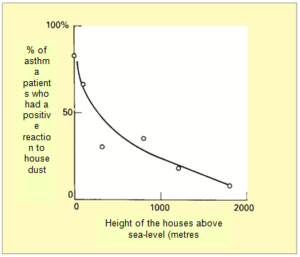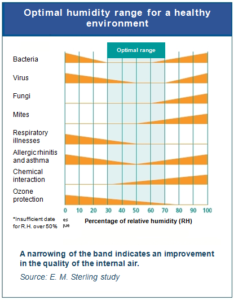
L’importance de contrôler l’humidité de l’air
In our long experience in the field of HVAC (heating, ventilation and air-conditioning), we have found that controlling humidity has been until now one of the aspects of air conditioning that has been somewhat neglected. In our everyday experience we find many units switched off or out of order because either they cause the owner or maintenance technician a lot of problems or because due to their location in the installation they undergo significant deterioration in very short period of time. Our impression is that this component of the HVAC installation is often regarded as superfluous because, in general, there is little awareness of the negative effects of an environment with a very high or very low range of humidity, frequented by people. This article sets out to convince those responsible for the design, installation and maintenance of these installations of the importance for both people and buildings of keeping air vapour content under control. In this way we can swiftly relate this lack of control of humidity to a number of problems in buildings that we often encounter, namely:
1.- Comfort
Our perspiration evaporates to regulate our body temperature and dissipate internal heat. The low relative humidity typical of many interior environments in winter leads to an average temperature of 21-23ºC, perspiration evaporates and we feel colder than we really should at that temperature.
Conversely, in summer we find rooms that keep the air above the recommended maximum level of humidity for comfort, 50-70% R.H. (relative humidity) due to a lack or fault of humidity control and the body is unable to evaporate the perspiration we generate to dissipate our body heat.
In a study[1] conducted at comfort temperatures of 21.1 and 27ºC and with dew points between 2.2 and 20ºC, of 20 people engaging in sedentary activities and dressed in light clothing, it was shown that the psychological response to thermal comfort (not acting to adjust it by, for example, opening the window, removing clothing, etc.) 90% of the individuals felt better when the R.H. was in the region of 50%. This is reflected in figure 1, where the TAC (Thermal Acceptance for Comfort) is supported, at comfort temperatures, by the largest number of individuals for a R.H. of around 50%.
[1] Berglund, L. G. y W. S. Cain. 1989. “Perceived air quality and the thermal environment.” The Human Equation: Health and Comfort. Proceedings of ASHRAE/SOEH Conference IAQ ’89 Atlanta: ASHRAE, pp. 93-99.
2.- Health
Dryness of the skin directly affects several metabolic functions, including oxygen intake, the shedding of water vapour, salts, heat, etc. Excessive evaporation of this water vapour means that its replacement via capillary diffusion is insufficient and problems arise related to the dryness of the skin, whose effects we have only recently become aware of.
It is also useful to know that several studies have shown that at very low or very high levels of humidity, micro-organisms find environments that are more favourable for their survival. This happens for three reasons:
- At high humidity, moulds thrive and to survive they emit spores (the typical « damp smell ») to prevent others from growing. These spores undermine the operation of our immune system.
- As humidity increases, the amount of dust present in the atmosphere diminishes, both in terms of its production and its maintenance in suspension, as the humidity encourages deposition due to gravity. The amount of dust present in an environment impacts directly on our health, as the micro-organisms travel by adhering to these solid particles.
- Finally, at low humidity, the mucous membranes that prevent harmful bodies from getting inside our body do not perform their protective role.
This interaction of the human body is revealed in several studies which have shown that there is a relationship between the humidity level in an enclosed space and the proliferation of mites[1]. The droppings of these mites and insects are a rich source of food for moulds that thrive among persons with respiratory illnesses, such as rhinitis or asthma. The same studies have revealed that children and adolescents are more prone to these illnesses.
Around 50% of an insect’s body is composed of water. If it loses this water, the insect is less active and has a lower reproduction rate. Moderate temperatures with high humidity are the ideal medium for it to grow.
By reducing the humidity in buildings, we can limit the proliferation of mites and insects.
In figure 2, we can see how, as the height of the home above sea level increases, the number of asthma patients suffering from positive reactions to dust in the home decreases. For the same air condition, the air humidity decreases as the height above sea level increases.
3.- Static electricity and IT equipment failure
Air with a relative humidity of under 45% permits electro-static charges to accumulate in many types of IT equipment and even in people. Static electricity originates in our environment continuously due to the friction of materials with high electrical resistance against one another. A typical example is when people walk on carpet. This electricity is only a problem when the ambient conditions allow it to accumulate, which not only causes unpleasant effects such as when a person receives a discharge, but also when there is an explosive or inflammable atmosphere, with the risk that this represents.
In addition, these phenomena are very important in computer rooms and data processing centres, where they can cause problems such as electronic faults in circuits, dust accumulations on reader heads and even breakage of stored magnetic media.
Increasing R.H. does not prevent the forming of these charges, but it does prevent their accumulation. Suitable increases in R.H. produces a fine layer of humidity on the surfaces of the materials that allows the charges to travel to earth before they reach high levels of potential.
Figure 3 shows the measurement of electro-static discharges produced in a workplace with carpeting according to the relative humidity of the environment.
4.- Enhanced efficiency
Many times we find that the consumption of the terminal units in temperature control rooms, such as a split, is very high. This is generally accompanied by a significant evacuation of condensates.
If a more exhaustive analysis is conducted of this situation, it may be concluded that the energy consumption is used not only to cool the air, but also to dehumidify it.
The dehumidifying, in this particular case, is an energy loss, or to put it another way, a financial loss, which can be avoided if the humidity in the primary air feed is regulated. This can be done, for example, with an enthalpic recuperator that reduces the humidity load. Approximately 80% of latent heat loads come from outside air.
In this way, the heating units will be used specifically for sensitive control, reducing their energy consumption.
A sustainable focus on machines used for buildings is very important as according to date from the European Union ( Directive 2002/91/EC) we consume 40% of the energy we produce in them. HVAC machines and their auxiliary elements have to become increasingly compatible with renewable energy sources and the maximum efficiency of energy use.
5.- Deterioration of materials in buildings
Corrosion
A host of metal elements are to be found in buildings and these will be more or less important depending on what they are used for. This use can vary from a structural element to an ornamental function. Examples of typical failures in materials caused by this kind of degrading are the loss of mechanical properties, warping, pitting, joint failures, etc. This entails the replacement of the element in questions and the cost that this represents.
A metal corrodes when an electrical current flows from an area with more potential to one with less. This phenomenon is accelerated when there is an electrolyte present, such as a fine film of water.
This film of water is formed, in broad terms, due to the condensation of the relative humidity present in the air around a metal surface. This is either through the impact of the air particles on the metal or because there is a thermal bridge because this surface is at a temperature that is lower than the ambient temperature. In both cases, the condensate increases as the air’s R.H. increases.
According to studies by J.C. Hudson[1], there is a critical R.H. for each metal from which the rate of corrosion increases exponentially.
Humidity in partition walls and ceilings
In humid climates, it may happen that negative pressure is generated due to air extractions. This would lead to air filtering into the building, collecting in cavities between partition walls and ceilings. If there is an area where the temperature is lower than that of the infiltrated air such as behind a curtain or a sofa, this may cause saturation and even condensation. This would provide sufficient humidity for the growth of mould, showing up as what are popularly known as « rising damp ».
Humidity in bookshops
Something similar occurs in bookshops. However, here there is a further problem: they retain humidity. Thus, it is not just a question of a type of humid or damp climate, but of humid/damp months throughout the year. Every time the relative humidity rises by approximately 50%, the books will absorb humidity without releasing it. This becomes more serious still in book depositories and warehouses.
For this, a possible solution is to install a dehumidifier that maintains the R.H. below that figure at all times, regardless of the temperature.
6.- Conclusion
As we have already mentioned in the preceding paragraphs, humidity control is important not only from the point of view of material conservation but also in terms of human health.
By material conservation we mean preserving the properties and characteristics of the elements that form part of the building, on a permanent or temporary basis. The issue that is most worrying in this regard is corrosion. For this reason, rigorous control of relative humidity can help to prevent losses of materials, with the resulting financial loss.
More important still are the aspects related to human health, such as the proliferation of fungi, insects, viruses, and bacteria. We have already commented briefly on how the ambient conditions can affect their development, one of the chief factors being relative humidity. The consequence of ignoring such factors can lead to respiratory illnesses, which in principle are avoidable, such as allergies, asthma or rhinitis.
In the following figure, and in summary form, one can see the intervals of relative humidity in which the various organisms studied co-habit.
To sum up then, the limits set by the RITE in terms of relative humidity are neither capricious nor arbitrary – they seek to prevent the problems we have described.
Other added benefits stem from humidity control, such as an energy saving in the air conditioning of rooms, preventing the accumulation of static charges that can be generated by the friction of materials, and contributing to higher performance of IT equipment.
Fortunately, the trend in recent years has been to return to prevailing concept of the importance of controlling R.H. and so this is increasingly viewed as being of equal importance to controlling temperature.
8.- Bibliography
- ”Humidity control design guide for commercial and institutional buildings”. Harriman, L., Brundrett, G., Kittler, R., Ed. ASHRAE, 2006.
- “Montajes e Instalaciones. La importancia de la humedad relativa en la calidad ambiental”. Rodriguez Ramos, P. Ed. Separata, Septiembre 1992.
- “Humidification Handbook”. Morton, B. W. Ed. DriSteem, 1998.
- Real Decreto 1027/2007 de 20 de julio, por el que se aprueba el Reglamento de instalaciones térmicas en los edificios. RITE 2007.
- Real Decreto 1826/2009 de 27 de noviembre, por el que se modifica el Reglamento de instalaciones térmicas en los edificios.











Laisser un commentaire